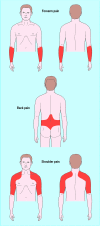Role of mechanical and psychosocial factors in the onset of forearm pain: prospective population based study
- PMID: 10987773
- PMCID: PMC27483
- DOI: 10.1136/bmj.321.7262.676
Role of mechanical and psychosocial factors in the onset of forearm pain: prospective population based study
Abstract
Objective: To determine the aetiology of forearm pain. In particular to determine the relative contribution of (a) psychological factors, features of somatisation, and health anxiety and behaviour, (b) work related mechanical factors, and (c) work related psychosocial factors in the onset of forearm pain.
Design: 2 year prospective population based cohort study, with retrospective assessment of exposures at work.
Setting: Altrincham, Greater Manchester.
Participants: 1953 individuals aged 18-65 years.
Outcome measures: Forearm pain of new onset.
Results: At follow up, 105 (8.3%) participants reported forearm pain of new onset lasting at least one day in the past month. Among these, 67% also reported shoulder pain, 65% back pain, and 45% chronic widespread pain. Increased risks of onset were associated with high levels of psychological distress (relative risk 2.4, 95% confidence interval 1.5 to 3.8), reporting at least two other somatic symptoms (1.7, 0.95 to 3.0), and high scores on the illness behaviour subscale of the illness attitude scales. The two work related mechanical exposures associated with the highest risk of forearm pain in the future were repetitive movements of the arm (4.1, 1.7 to 10) or wrists (3.4, 1.3 to 8.7), whereas the strongest work related psychosocial risk was dissatisfaction with support from colleagues or supervisors (4.7, 2. 2 to 10).
Conclusions: Psychological distress, aspects of illness behaviour, and other somatic symptoms are important predictors of onset of forearm pain in addition to work related psychosocial and mechanical factors. Misleading terms such as "cumulative trauma disorder" or "repetitive strain injury," implying a single uniform aetiology, should be avoided.
Figures
Similar articles
-
The role of workplace low-level mechanical trauma, posture and environment in the onset of chronic widespread pain.Rheumatology (Oxford). 2003 Dec;42(12):1486-94. doi: 10.1093/rheumatology/keg399. Epub 2003 Jul 16. Rheumatology (Oxford). 2003. PMID: 12867586
-
Mechanical injury and psychosocial factors in the work place predict the onset of widespread body pain: a two-year prospective study among cohorts of newly employed workers.Arthritis Rheum. 2004 May;50(5):1655-64. doi: 10.1002/art.20258. Arthritis Rheum. 2004. PMID: 15146437
-
Predicting the onset of forearm pain: a prospective study across 12 occupational groups.Arthritis Rheum. 2003 Aug 15;49(4):519-25. doi: 10.1002/art.11202. Arthritis Rheum. 2003. PMID: 12910558
-
Repetitive strain injury.Postgrad Med J. 2004 Aug;80(946):438-43. doi: 10.1136/pgmj.2003.012591. Postgrad Med J. 2004. PMID: 15299151 Free PMC article. Review.
-
Occupational risk factors associated with soft tissue disorders of the shoulder: a review of recent investigations in the literature.Ergonomics. 1993 Jun;36(6):697-717. doi: 10.1080/00140139308967931. Ergonomics. 1993. PMID: 8513776 Review.
Cited by
-
Effect of specific resistance training on forearm pain and work disability in industrial technicians: cluster randomised controlled trial.BMJ Open. 2012 Feb 13;2(1):e000412. doi: 10.1136/bmjopen-2011-000412. Print 2012. BMJ Open. 2012. PMID: 22331386 Free PMC article.
-
The impact of workplace risk factors on the occurrence of neck and upper limb pain: a general population study.BMC Public Health. 2006 Sep 19;6:234. doi: 10.1186/1471-2458-6-234. BMC Public Health. 2006. PMID: 16984657 Free PMC article.
-
Predicting the onset of knee pain: results from a 2-year prospective study of new workers.Ann Rheum Dis. 2007 Mar;66(3):400-6. doi: 10.1136/ard.2006.057570. Epub 2006 Aug 25. Ann Rheum Dis. 2007. PMID: 16935910 Free PMC article.
-
The CUPID (Cultural and Psychosocial Influences on Disability) study: methods of data collection and characteristics of study sample.PLoS One. 2012;7(7):e39820. doi: 10.1371/journal.pone.0039820. Epub 2012 Jul 6. PLoS One. 2012. PMID: 22792189 Free PMC article.
-
Low typing endurance in keyboard workers with work-related upper limb disorder.JRSM Short Rep. 2011 May;2(5):34. doi: 10.1258/shorts.2011.010144. Epub 2011 May 3. JRSM Short Rep. 2011. PMID: 21637395 Free PMC article.
References
-
- Helliwell P. London: Baillière Tindall; 1999. The elbow, forearm, wrist and hand. In Clinical rheumatology: regional musculoskeletal pain. Eds P Croft and PM Brooks; pp. 311–328. - PubMed
-
- Hunt IM, Silman AJ, Benjamin S, McBeth J, Macfarlane GJ. The prevalence and associated features of chronic widespread pain in the community using the “Manchester” definition of chronic widespread pain. Rheumatology. 1999;38:275–279. - PubMed
-
- Ritchie J, Jacoby A, Bone M. Access to primary health care. London: Office for Population Censuses and Surveys social survey division: HMSO; 1981.
-
- Goldberg D, Williams P. A user's guide to the general health questionnaire. Windsor: NEFR-Nelson; 1988.
Publication types
MeSH terms
LinkOut - more resources
Full Text Sources
Medical
Miscellaneous

